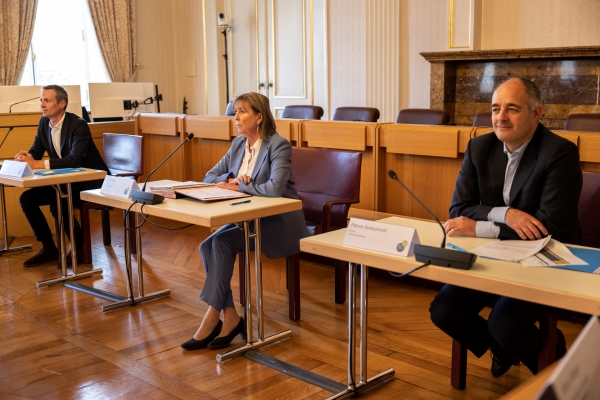 Credit: (c) VDL Photothèque / Charles Soubry
Credit: (c) VDL Photothèque / Charles Soubry
On Wednesday 21 September 2022, the City of Luxembourg (Ville de Luxembourg - VdL) presented the energy saving measures which have been adopted by the college of mayors and aldermen in order to reduce energy consumption in buildings and infrastructures belonging to the municipal administration of the city.
The city is rallying to the efforts of administrations, businesses and citizens aimed at reducing the demand for natural gas by 15% over the reference period from 1 August 2022 to 31 March 2023 in order to increase the security of energy supply in the country.
Through a detailed analysis of the city's services, various measures to significantly reduce energy consumption have been identified and have already been implemented or will be implemented shortly.
Buildings
- The ambient temperature will be adapted according to the recommendations of the Labour and Mines Inspectorate (see table).

- The current process of replacing tube luminaires with LED luminaires is accelerated.
Sports infrastructure
- Swimming pools: Ambient and water temperatures will be significantly reduced. Initially, the water temperature in the swimming pools currently between 27.5°C and 29°C will change to a temperature between 26.5°C and 27°C. The temperature of the non-swimming pools will drop from 31°C to 29°C. The ambient temperature currently between 29.5°C and 31°C will be between 28.5°C and 29°C. This measure will save about 12% of energy. Additional temperature adjustments may be implemented after evaluation of the situation and the savings made.
- Omnisports halls: The ambient temperature will be significantly lowered. Initially, the temperature will drop from 20°C to 18°C, which will save about 12% of energy. An additional temperature adjustment may be implemented after evaluation of the situation and the savings made.
Lighting of streets and buildings
- Lighting of streets and public places: The sensitivity of the sensor that controls the activation of public lighting, currently more sensitive on the territory of the City, will be aligned with the national standard with a view to a reduction of approximately one hour of the daily activation period, i.e. an 8% drop in annual consumption.
- Fortress lighting: The activation of the lighting will align with the new setting prescribing the activation of street lighting. The lighting, currently set at 01:00, will be switched off at 22:00, i.e. a reduction of more than three hours per day. This measure corresponds to a reduction of approximately 49% in the annual energy consumption of the lighting of the fortress.
- Lighting of the Ban de Gasperich water tower: The water tower will only be illuminated for exceptional occasions.
- Lighting of city buildings: Official buildings will only be illuminated during events, with the exception of the Cercle Cité which continues to be illuminated as usual.
- Lighting of the Stade de Luxembourg: The facade will only be illuminated during sporting events.
- Lighting of trees on the Place d'Armes: The current duration of the lighting activation will be reduced from nineteen hours per day (06:00 to 01:00) to six hours per day (17:00 - 23:00), a reduction of approximately 68% annual energy consumption.
Winterlights
- Christmas illuminations: The duration will decrease from nineteen hours per day (06:00 to 01:00) to a maximum of approximately six hours per day (activation with public lighting and until 23:00), with the exception of Christmas days when the lighting will remain on until 01:00, representing a reduction of around 66% in the annual consumption of Christmas lights.
- No installations of new light patterns.
- No installation of an ice rink, i.e. a saving of 165 MWh, which is equivalent to a reduction of just under a third of the electricity consumption of Christmas markets.
- Ban on radiant heaters in the Christmas market.
Changes in the management of the city's buildings and infrastructure will be accompanied by training and awareness-raising for janitors, cleaning teams and infrastructure users (eg clubs and associations) as well as an internal campaign to aimed at all of the city's employees in order to make them aware of the small gestures that make it possible to save energy in the workplace.
Thanks to all of these measures, the City of Luxembourg aims to reduce gas consumption by 15% and save electricity by around 5%. It should be noted that the above measures may be adapted and additional arrangements may be made depending on the evolution of the situation. These newly adopted measures are part of the continuity of the efforts already implemented in terms of climate protection. Thus, they reinforce existing commitments to reduce primary energy needs and increase the production of renewable energies with a view to reducing CO2 emissions by 55% by 2030 compared to the 2014 reference year. The city is therefore committed to continuing its efforts to both protect the climate and strengthen the security of the country's energy supply.
In addition, the city recalls that an energy bonus was voted on at the municipal council meeting of 28 March 2022 following the rise in energy prices at the start of the year. Thus, anyone living in the City of Luxembourg and having received the energy bonus from the State, can claim the municipal energy bonus. The amount of the energy bonus is identical to that paid by the State and ranges between €200 and €400 depending on the size of the household. The college of aldermen, aware of the impact of the upcoming tariff increases, is considering additional provisions to support residents of the capital.








